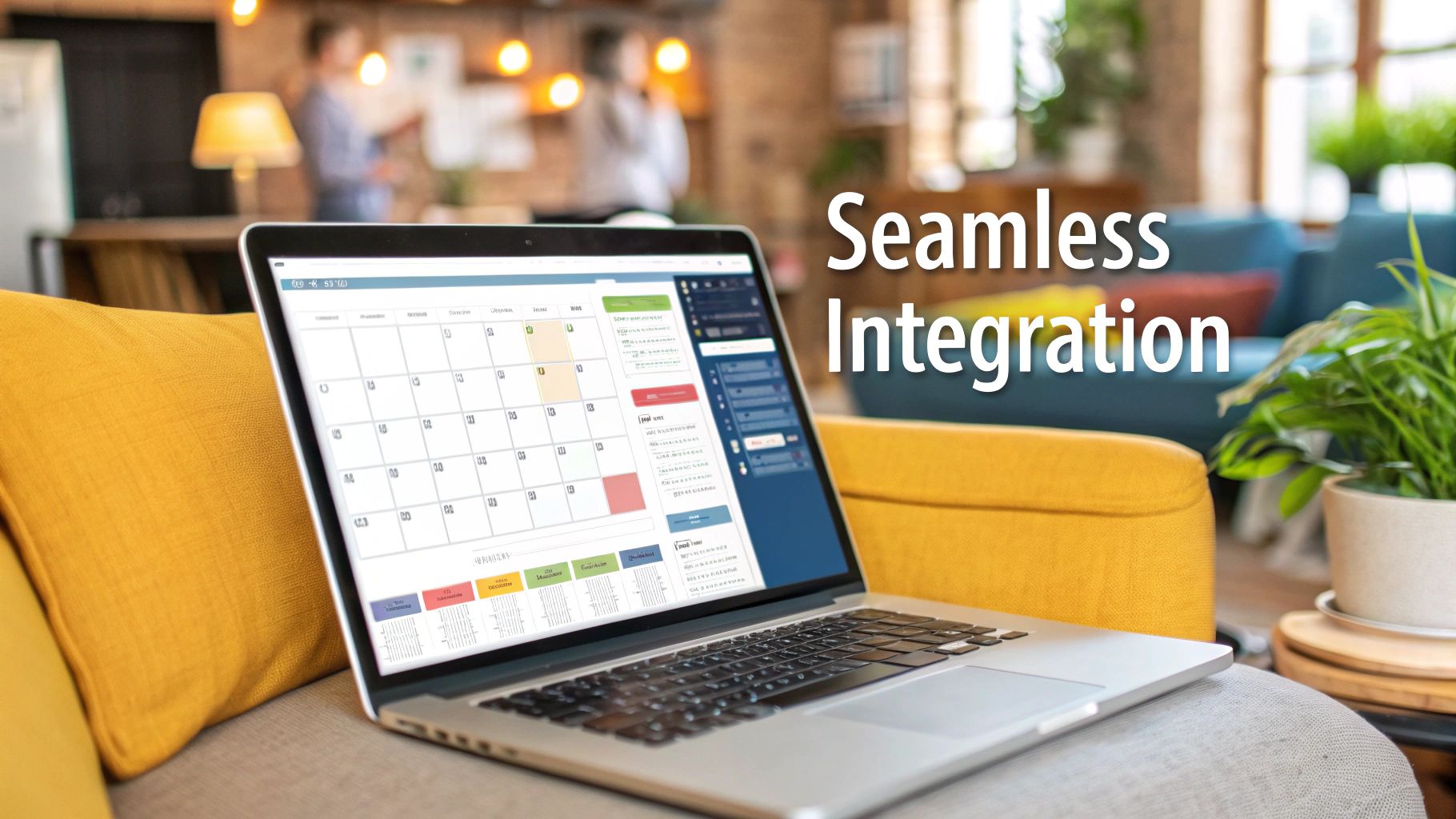From our resource library for organizational scheduling and management.
Employee Scheduling Program: The Complete Guide to Modern Workforce Management

Why Traditional Scheduling Methods Are Failing Modern Teams

Managing employee schedules effectively has become a major challenge for businesses. Many companies still rely on basic tools like spreadsheets, whiteboards, or paper-based systems to handle their scheduling needs. These outdated methods simply can't keep up with the complex scheduling demands of today's workplaces, leading to wasted time and higher costs.
Take the daily challenges of managing shift swaps and time-off requests. When using manual scheduling methods, even small changes can spiral into major headaches. A single scheduling error can trigger a chain reaction of conflicts that frustrates employees and drains managers' time. These basic tools also make it nearly impossible to quickly respond when employees call in sick or availability changes unexpectedly.
The statistics paint a clear picture of the problems with traditional scheduling approaches. According to recent studies, 80% of employee timesheets contain errors. Even more concerning, 38% of U.S. workers still track their time using old-school methods like punch cards and paper sheets. For more insights on this topic, check out these employee scheduling statistics. These error-prone processes directly impact labor costs and create compliance risks.
The Hidden Costs of Inefficient Scheduling
Poor scheduling practices hurt businesses in ways that aren't immediately obvious. When managers can't properly plan staffing levels, they often end up paying unnecessary overtime. Employee morale suffers from constant schedule conflicts and last-minute changes. Customer service takes a hit when shifts are understaffed. Over time, these issues can seriously damage a company's bottom line.
The Solution: Modern Employee Scheduling Programs
Employee scheduling programs like Acroroster offer practical solutions to these common challenges. These tools provide one central place to handle all scheduling tasks - from creating shifts to managing time-off requests and team communication. By automating the tedious parts of scheduling, managers can focus on more important work. To learn more about improving your scheduling process, check out this guide on how to master your schedule.
Making the switch to scheduling software helps businesses run more smoothly while keeping employees happier. Teams can communicate better, managers spend less time on administrative tasks, and scheduling headaches become a thing of the past. For companies still using old-school scheduling methods, choosing the right scheduling program is an important step toward building a more efficient workplace.
Transforming Operations Through Digital Scheduling Solutions

Modern employee scheduling software does much more than just move paper schedules onto a computer. These tools completely change how companies manage their teams, giving managers the power to make better staffing decisions, reduce expenses, and create happier employees. The results show up directly in improved business performance.
Streamlining Administrative Tasks with Automation
Think about all the time managers spend building schedules, handling shift trades, and processing time-off requests. These basic tasks can eat up hours of each workday. Digital scheduling tools take over this busy work automatically, which means managers can focus on more important priorities. Companies typically see their administrative work drop by up to 70% after implementing these systems. Plus, the automated schedules have far fewer conflicts and mistakes than manually created ones.
Empowering Employees Through Accessibility and Flexibility
These scheduling tools put more control in employees' hands. Staff members can check their schedules, request time off, and swap shifts right from their phones - no more confusing email chains or phone tag. This independence helps create better work-life balance and job satisfaction. Workers appreciate being able to manage their own scheduling needs quickly and easily, which builds a more positive workplace culture.
Boosting Operational Efficiency and Cost Savings
Better scheduling directly impacts a company's financial results. The software helps match staffing levels to actual business needs using both real-time and historical data. Companies using these systems report impressive results: an 88% improvement in shift coverage, 23% lower overtime costs, and 55% fewer scheduling mistakes. Managers also create schedules 30% faster than before. Discover more insights about employee scheduling software. Employee complaints about schedules drop by 26%, showing better compliance and satisfaction.
Real-World Examples of Transformation
From major retail chains to round-the-clock healthcare facilities, businesses across many industries now rely on digital scheduling. The software adapts easily to handle different scheduling needs - whether it's managing hundreds of retail workers across multiple stores or ensuring 24/7 hospital coverage. This flexibility helps companies respond quickly as their staffing needs change. Most importantly, these tools create happier employees while running more efficient operations, leading to stronger business results overall.
Breaking Through Implementation Barriers

Moving to a new employee scheduling system takes more than just picking good software. Success depends on getting your team fully on board and helping them use it effectively. Let's look at how to tackle the common challenges that come up during this transition.
Understanding and Addressing Resistance to Change
People naturally resist changes to their daily work routines. Your staff may prefer familiar scheduling methods, even if they're not the most efficient. Studies show that 70% of new system rollouts fail because employees push back and managers don't provide enough support. This often happens when people feel uncertain about learning new tools or doubt the benefits of switching. Learn more about adoption challenges.
Effective Communication and Training Strategies
Clear, honest communication helps overcome resistance. Take time to explain why you're making the change and how it will make everyone's work easier. For instance, point out specific benefits like easier shift swaps, automated time-off requests, and being able to check schedules on phones. Back this up with thorough training that works for different learning styles - offer in-person workshops, video guides, and quick reference materials so everyone can learn in a way that suits them.
Building Momentum and Ensuring Long-Term Adoption
Getting people to stick with the new system takes ongoing effort. Ask for feedback regularly and show that you're listening by making adjustments based on what you hear. Notice and thank team members who embrace the change early on. This creates positive energy that helps others want to get on board too.
Planning for Success: Timelines and Risk Mitigation
Map out your implementation with clear deadlines for training, system launch, and follow-up support. Think through what could go wrong - like tech issues or problems moving data from old systems. Have backup plans ready for these scenarios. This preparation helps you handle bumps in the road smoothly and keeps the transition on track toward successful adoption of your new scheduling system.
Essential Features That Drive Real Results
When selecting an employee scheduling program, it's important to look past fancy extras and focus on what actually works. The best features are ones that make scheduling easier, keep your team engaged, and help your business run smoothly. Before investing in new software, consider which tools will solve your specific scheduling challenges.
Must-Have Functionalities for Effective Scheduling
A good scheduling program does more than just replace paper schedules - it helps you stay ahead of staffing needs instead of constantly reacting to changes. Here are the key features to look for:
- Automated Scheduling: Smart systems that create schedules based on your rules, when people can work, and past patterns. This saves managers hours of work each week and helps prevent scheduling mistakes.
- Mobile Access: Give staff the ability to check schedules, request time off, and swap shifts right from their phones. This puts more control in their hands and helps them better balance work and life.
- Quick Communication: Built-in messaging lets managers and staff easily stay in touch about schedule changes and updates. This helps prevent confusion and lets everyone respond faster when plans change.
- Clear Reports: Track important numbers like labor costs, extra hours, and whether people show up as scheduled. Having this data helps you spot problems early and make better decisions about staffing.
Integration and Scalability: Future-Proofing Your Solution
Think about how well the scheduling program works with your other systems and whether it can grow with your business.
- Payroll Connection: Link scheduling data directly to your payroll system to save time and reduce errors from manual data entry.
- Room to Grow: Pick a system that can handle more employees and locations as your business expands. You want software that remains useful years from now. You might be interested in: How to master your digital schedule management.
Building Your Feature Requirements List
Start by listing the scheduling problems that cause the biggest headaches. Are you spending too much on overtime? Is managing shift swaps taking up too much time? Do schedule mix-ups happen because of poor communication?
Match your main problems to specific features that can help. If overtime costs are high, look for automated scheduling that watches work hours. If shift changes are messy, focus on mobile access and better communication tools. By picking features that tackle real issues, you'll make scheduling smoother and your team happier. This approach saves money and improves how employees feel about their jobs. Most importantly, you'll have a scheduling system that can adapt as your business needs change.
Mastering Digital Schedule Management
Creating an effective employee scheduling system goes beyond installing software. It's about building reliable processes, maintaining clear communication channels, and developing a system that grows with your team. When done right, good scheduling reduces conflicts between team members, keeps employees happy, and helps operations run smoothly.
Building Robust Scheduling Policies
Clear scheduling rules form the foundation of good workforce management. Your policy needs to spell out the basics - how shifts get assigned, deadlines for time-off requests, and steps for switching shifts. For example, set specific rules like "Submit vacation requests 14 days ahead" or "All shift trades need manager approval." Being upfront about these expectations prevents confusion and arguments later.
Having detailed policies also helps protect everyone involved. Make sure your rules follow all required labor laws and regulations. Write them down clearly so both employees and managers know exactly what's expected.
Streamlining Time-Off and Shift Swaps
Paper schedules make handling time-off requests and shift changes a real hassle. An employee scheduling program simplifies these tasks by putting everything in one digital system. Staff can submit time-off requests through the platform, and managers can quickly approve or deny them. The system keeps a record of all requests, making it simple to check past decisions and ensure proper coverage.
The same goes for shift swaps - employees can propose trades directly in the system. Managers still oversee the process but spend less time coordinating changes between team members.
Maintaining Labor Law Compliance
Following labor laws isn't optional. Good scheduling software helps keep you on track by monitoring things like work hours, break times, and overtime. The system can warn you before problems occur - like if someone is scheduled for too many hours without breaks. Having everything recorded digitally also creates a paper trail that proves you're following the rules.
Handling Complex Scheduling Scenarios
Most businesses deal with tricky scheduling situations, whether it's juggling part-timers, handling busy seasons, or coordinating multiple locations. The right scheduling program can handle these challenges. It lets you set up different shift types, track when people are available, and connect with your payroll system.
This flexibility means the program can adapt as your business grows and changes. When used well, digital scheduling creates an organized system that works for both managers and employees, leading to a more productive workplace where people actually want to work.
Measuring and Maximizing Your Scheduling ROI
A well-designed employee scheduling program does much more than assign shifts - it's a key business tool that affects your financial success. To get the most from your investment, you need clear metrics, solid data analysis, and consistent refinement of your scheduling approach.
Identifying Your Key Performance Indicators (KPIs)
Start by choosing metrics that match what matters most for your business performance. Whether you want to cut labor expenses, reduce extra hours, or boost staff satisfaction, you'll need specific numbers to track. Here are the essential metrics to monitor:
- Labor Cost Percentage: Compare your staffing costs to total revenue. Lower percentages typically show better efficiency.
- Overtime Hours: Watch these numbers closely to spot patterns and find ways to reduce unnecessary extra time.
- Employee Turnover: Poor scheduling often leads to staff leaving, which costs more than you might think. Good scheduling helps keep your team happy and stable.
- Schedule Adherence: See how well your team follows their assigned schedules to catch issues like late arrivals or no-shows early.
Gathering and Analyzing Scheduling Data
Today's scheduling software makes it simple to collect and review your scheduling information. Use these features to create clear reports that show what's working and what isn't. For example, you might notice that certain shifts regularly run into overtime, showing you where to make changes.
You might be interested in: Additional resources for maximizing your scheduling program.
Calculating Your ROI
To measure your return on investment, compare what you spend on scheduling software against what you save. Direct ROI shows up in concrete numbers like reduced overtime costs and better labor efficiency. Indirect ROI includes benefits like happier employees and better productivity - harder to measure but just as important. Here's a simple example: if your scheduling program saves $1,000 monthly in overtime while costing $200, that's a 500% direct return.
Communicating the Value of Your Scheduling Program
Show your team and leadership exactly how the scheduling program helps the business. Use clear data and real examples to demonstrate improvements in your key metrics. This helps everyone understand why the investment matters and how it makes the business better.
Continuous Optimization for Long-Term Success
Getting the most from your scheduling program takes ongoing attention. Keep checking your metrics, looking at the data, and adjusting your approach. This steady focus ensures your employee scheduling program keeps delivering value year after year.
Ready to improve your scheduling approach? See how Acroroster can help your team work better. Explore Acroroster today!
Article created using Outrank